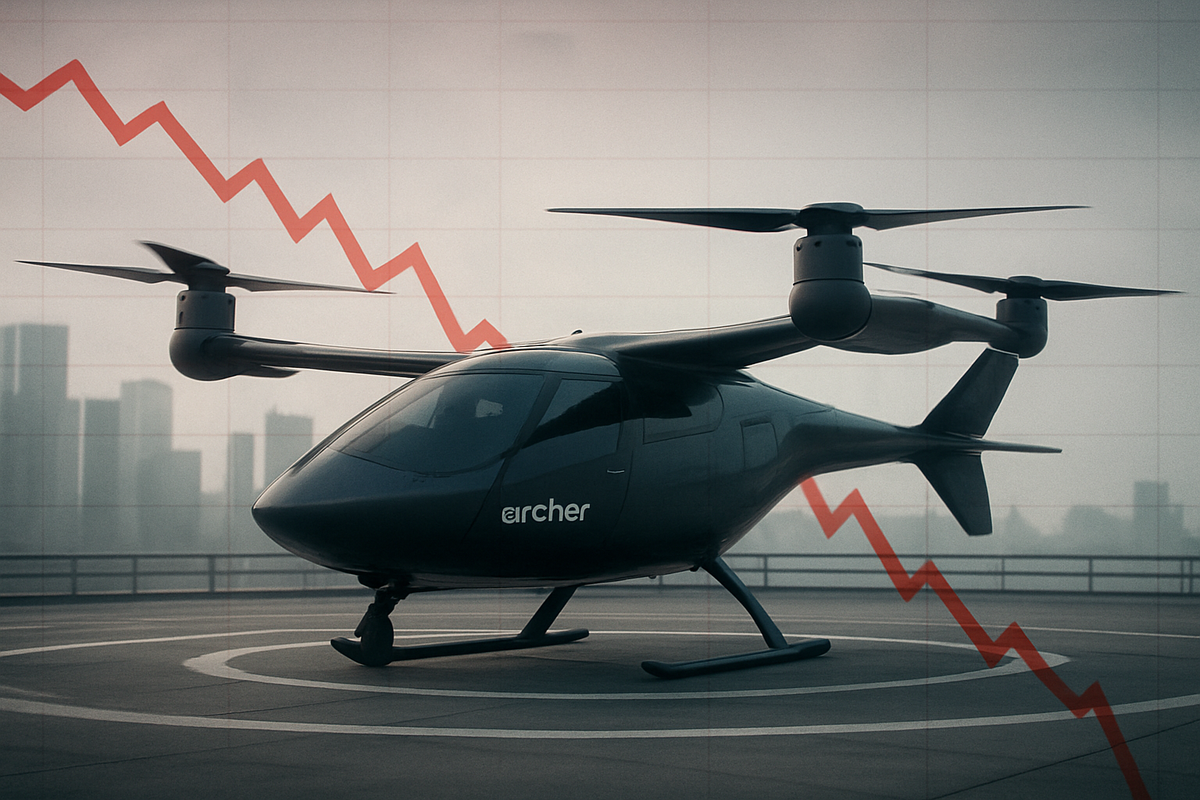
On November 3, 2025, Archer Aviation (NYSE: ACHR) experienced a notable downturn in its stock performance, with shares closing down 6.8%, and in intraday trading, the decline was as much as 9.89%. This movement has drawn significant attention and speculation among investors, particularly given the company's position as a pre-revenue enterprise at the forefront of the electric vertical takeoff and landing (eVTOL) aircraft sector. The immediate implications of such a drop include reduced investor confidence, increased stock volatility, and intensified scrutiny on the company's financial health and its long-term path to profitability. This decline signals a market recalibration, pushing investors to look beyond individual company news to broader industry realities, especially concerning regulatory hurdles and capital burn rates.
The downturn appears to be a confluence of company-specific developments and broader market dynamics affecting the nascent eVTOL industry. While a significant rally of 264% over the past year for Archer may have led to some profit-taking, the market's sensitivity to execution risk, regulatory timelines, and financial viability within the advanced air mobility (AAM) industry remains paramount.
Detailed Coverage of the Event
The 6.8% stock decline for Archer Aviation (NYSE: ACHR) on November 3, 2025, occurred amidst a backdrop of critical developments and anticipation within the eVTOL sector. While no single catastrophic event was reported, the decline was likely influenced by a combination of factors that collectively dampened investor sentiment.
Leading up to this date, Archer Aviation has been actively engaged in numerous strategic initiatives and has also faced critical regulatory hurdles. The company is working towards achieving Federal Aviation Administration (FAA) Type Certification for its Midnight aircraft, a crucial step for commercial passenger operations. As of July 2025, Archer had secured three of four critical FAA certifications (Part 135 Air Carrier & Operator, Part 145 Repair Station, and Part 141 Pilot Training Academy), but the final Type Certification was still pending, initially expected by late 2025. However, reports emerged in October 2025 indicating that full certification for passenger flights in the UAE, a key market for Archer, was likely to be delayed until 2026 due to longer-than-anticipated review times by regulatory authorities. Such delays in the Type Inspection Authorization (TIA) process can significantly impact Archer's 2025 launch timeline, creating volatility for investors.
Adding to the market's anticipation, Archer Aviation was scheduled to report its third-quarter 2025 operating update and financial results after market close on Thursday, November 6, 2025. Ahead of this report, analysts expected Archer to report a loss per share of $0.30 for Q3, with projected revenues at $400,000. For a pre-revenue company, these figures are critical, as investors closely scrutinize cash burn and progress toward commercialization. Any pre-earnings jitters or negative sentiment leading into this report could have contributed to the stock's decline.
In terms of strategic partnerships and expansion, October 2025 was a busy month for Archer. The company signed an agreement with Korean Air to introduce its Midnight eVTOL aircraft in South Korea, with Korean Air intending to purchase up to 100 aircraft. Archer also acquired approximately 300 patent assets from Lilium GmbH for about €18 million, expanding its patent portfolio to over 1,000 assets worldwide, strengthening its technological edge. Furthermore, Archer was named the exclusive Air Taxi Partner of the Los Angeles Sports & Entertainment Commission, supporting major upcoming events. Collaborations with Cleveland Clinic Abu Dhabi and earlier partnerships with Anduril for defense applications and Jetex for global infrastructure integration also highlight Archer's aggressive growth strategy.
Key players involved in this scenario include Archer Aviation Inc. (NYSE: ACHR) itself, the FAA and UAE Regulatory Authorities (GCAA) whose certifications are vital, and investors and analysts who are closely watching Archer's progress. Competitors such as Joby Aviation (NYSE: JOBY), Lilium (NASDAQ: LILM), and AutoFlight are also making their own strides in the advanced air mobility sector, adding to the competitive pressure. The initial market reaction, as evidenced by the 6.8% stock decline, suggests a negative sentiment, potentially influenced by the reported delay in UAE certification for passenger flights and the impending Q3 earnings report. Despite generally bullish analyst sentiment and a remarkable 242% surge over the past year, the stock's pre-revenue valuation makes it vulnerable to such dips, reflecting that the market views it as a "big leap of faith."
Companies on the Rise and Fall
The 6.8% stock decline experienced by Archer Aviation (NYSE: ACHR) on November 3, 2025, is not an isolated event but rather a reflection of the inherent volatility and speculative nature of the nascent eVTOL industry. This downturn has implications not only for Archer but also for its competitors and strategic partners.
Archer Aviation (NYSE: ACHR) itself is the primary loser in this scenario. As a pre-commercial, pre-revenue company, its stock performance is highly sensitive to news regarding its progress, partnerships, and the overall market sentiment for eVTOLs. A notable stock decline, even within the volatile eVTOL market, can erode investor confidence, potentially making future capital raises more challenging or expensive. While Archer boasts a substantial cash balance (over $1.7 billion in cash and cash equivalents as of Q2 2025) and is actively working to reduce its annual cash burn, sustained stock declines could put pressure on its valuation and liquidity over the long term. Operationally, while a single day's stock drop won't immediately halt progress, persistent downward pressure could affect its ability to fund manufacturing scale-up, R&D, and the critical FAA certification for its "Midnight" aircraft. The decline, especially if linked to broader industry concerns, could also lead to increased scrutiny from analysts and the public, potentially overshadowing recent positive developments like its expanded partnerships and patent acquisition.
Among competitors in the eVTOL space, the impact is likely widespread, with few outright winners in a declining market. Joby Aviation (NYSE: JOBY), for instance, saw its shares fall sharply by more than 9% on the same day, reportedly due to delays in its UAE certification process. This suggests a sector-wide impact rather than an isolated event for Archer, as negative news affecting one major player often creates a ripple effect across the entire industry. Other early-stage eVTOL companies such as Lilium (NASDAQ: LILM), Vertical Aerospace (NYSE: EVTL), and Eve Holding (NYSE: EVEX) are also likely to experience increased investor apprehension, potentially making it harder for them to raise capital or maintain valuations. JPMorgan (NYSE: JPM) had recently downgraded Joby Aviation, reflecting a more conservative outlook on the sector, and similar caution may extend to other players. While some companies like EHang (NASDAQ: EH) have achieved full regulatory approval and commenced limited commercial operations in China, setting them apart in terms of technical progress, their valuations are still impacted by general market sentiment towards the sector.
Significant partners of Archer Aviation also face potential implications. Stellantis (NYSE: STLA), a key partner providing equity capital and collaborating on manufacturing, has a vested interest in Archer's success. A stock decline could raise concerns about its investment, though given Stellantis's size and diversified business, the direct financial impact would likely be limited. However, it might prompt a re-evaluation of the timeline or scale of their collaboration. Airlines like United Airlines (NASDAQ: UAL) and Korean Air (KRX: 003490), which have placed orders for Archer's aircraft, might see potential delays in aircraft delivery, impacting their urban air mobility rollout plans. Nonetheless, their long-term strategic vision means a short-term stock fluctuation is unlikely to derail these partnerships entirely. Other partners involved in infrastructure development and operational concepts, such as Jetex, Southwest Airlines (NYSE: LUV), and various Abu Dhabi entities, might experience increased uncertainty regarding project timelines or future investment. Ultimately, the long-term success of Archer and the broader eVTOL market hinges on achieving regulatory certifications, scaling production, and demonstrating a viable commercial model, all of which are subject to market fluctuations and operational hurdles.
Wider Significance and Industry Trends
The 6.8% stock decline for Archer Aviation (NYSE: ACHR) on November 3, 2025, carries significant weight, extending beyond the immediate financial impact on the company. It serves as a stark market recalibration, indicating that investors are scrutinizing the broader realities of the eVTOL sector, including persistent regulatory hurdles and substantial capital burn rates, even amidst positive strategic developments. The simultaneous decline of Joby Aviation (NYSE: JOBY) stock on the same day underscores that these concerns are not isolated but rather indicative of sector-wide volatility and fragility.
This event fits squarely within several overarching eVTOL industry trends. The sector has attracted over $15 billion in investment by early 2025, yet publicly listed companies, particularly those that went public via SPACs, have frequently traded below initial valuations, highlighting the inherent volatility and speculative nature of this high-risk, high-reward market. Regulatory challenges remain a persistent theme; while the FAA has made strides in establishing a framework, "undefined standards" and "resource-intensive processes" for certification continue to delay commercialization timelines, fueling investor anxiety. Furthermore, the capital-intensive nature of developing eVTOL aircraft means companies like Archer continue to burn substantial cash, making the market highly sensitive to capital burn rates and the industry's estimated need for up to $40 billion to reach global commercial scale. As the industry transitions from development to initial commercialization, scaling manufacturing, building vertiport infrastructure, and gaining public acceptance remain considerable obstacles.
The ripple effects of Archer's stock decline can be felt across the industry. For competitors, the downturn could lead to increased scrutiny and pressure, potentially dampening investor enthusiasm for other players like Vertical Aerospace (NYSE: EVTL), Lilium (NASDAQ: LILM), and Eve Holding (NYSE: EVEX), making it harder for them to raise capital. This environment could also accelerate industry consolidation, forcing smaller or less-funded players to seek mergers or acquisitions. For partners such as United Airlines (NASDAQ: UAL), Stellantis (NYSE: STLA), and Anduril, a significant stock decline might prompt a re-evaluation of their commitments to Archer, potentially affecting future funding or orders, although their long-term strategic interests in urban air mobility are likely to persist.
From a regulatory and policy perspective, persistent investor concerns about certification timelines could pressure aviation authorities like the FAA and EASA to provide greater transparency, standardize requirements, or even accelerate parts of the approval process. Any perceived regulatory setbacks could intensify scrutiny and efforts to ensure public trust, which is crucial for widespread eVTOL adoption. The strategic interest from governments, evidenced by defense contracts, suggests that market downturns could also prompt increased government support or subsidies to ensure the continued development of this strategic technology.
Historically, the current situation in the eVTOL industry draws parallels to several periods of intense innovation, speculation, and eventual consolidation in emerging technologies. The Dot-Com Bubble of the late 1990s is a prominent comparison, where immense excitement and capital flooded into pre-revenue internet companies, leading to inflated valuations and a subsequent market crash. Like the internet, eVTOLs promise to revolutionize industries, but many companies are highly speculative, facing a similar risk of a "bubble burst" if market enthusiasm outpaces actual commercialization and profitability. Early automotive, radio, and aviation industries also experienced similar cycles of innovation, speculative investment, and market shakeouts, with only a few dominant players surviving. The "chasm effect," where emerging technologies struggle to cross from early adopters to the mainstream, is also highly relevant, as failures to achieve this can lead to stalled growth and declining stock prices. Archer's stock decline, therefore, may be an early indicator of the broader eVTOL market undergoing a necessary period of re-evaluation, where speculative valuations give way to a more realistic assessment of the substantial challenges and timelines involved in bringing this transformative technology to widespread commercial reality.
The Road Ahead: What Comes Next
The 6.8% stock decline for Archer Aviation (NYSE: ACHR) on November 3, 2025, underscores the inherent volatility of the eVTOL industry as it transitions from development to initial commercialization. This event, while a setback, also sets the stage for critical short-term and long-term developments for Archer and the broader sector.
In the short-term, Archer will face intensified scrutiny from investors and the media regarding its progress, cash burn, and certification timeline. As a pre-revenue company, its valuation is highly sensitive to market sentiment, and a sustained decline could make future fundraising more challenging or expensive. Archer will likely need to emphasize its immediate operational milestones, such as the commencement of Midnight eVTOL production in early 2025 at its Georgia facility, with a goal of two aircraft per month by year-end. Highlighting tangible progress in flight testing and FAA certification will be crucial for investor reassurance. Communication with strategic partners like United Airlines (NASDAQ: UAL) and Stellantis (NYSE: STLA) will also be vital to maintain confidence in their substantial investments and collaborations.
Looking at the long-term possibilities, Archer's future remains tied to the successful commercialization of its eVTOL aircraft and the growth of the Urban Air Mobility (UAM) market. The company aims for early commercial deployments of its Midnight aircraft in 2026, including an air taxi network with United Airlines. Scaling production to 650 aircraft annually by 2030 at its Georgia facility, in partnership with Stellantis, is critical for economic viability. Additionally, Archer Defense, the company's program to develop hybrid VTOL military aircraft with Anduril, could provide a significant, stable revenue stream and leverage technological advancements for commercial use. The development of a comprehensive air mobility ecosystem, including charging stations and maintenance facilities, is also part of Archer's long-term vision.
Strategic pivots or adaptations might be required for Archer to navigate market pressures. Diversifying revenue streams beyond passenger air taxis, potentially into cargo logistics or emergency services, could offer additional stability. Strengthening existing partnerships and exploring new ones for vertiport development and charging infrastructure will be crucial. A strong focus on cost optimization, supply chain efficiency, and leveraging automotive-grade supply chains will be paramount to extending its financial runway. Archer might also consider a more targeted market entry, focusing initially on high-demand, high-margin routes where the value proposition of eVTOLs is clearest and regulatory hurdles might be more manageable. The defense partnership with Anduril could also become a more significant strategic focus, providing a stable revenue stream and opportunities to mature technology before widespread commercial deployment.
The broader eVTOL industry presents both significant opportunities and substantial challenges. Opportunities include addressing urban congestion with greener solutions, continuous technological advancements in battery and propulsion systems, and supportive government policies from bodies like the FAA and EASA. The market is projected to grow significantly, with estimates ranging from $5.00 billion in 2025 to nearly $70 billion by 2040. However, formidable challenges persist, including complex certification hurdles and regulatory uncertainty, the lack of widespread vertiport infrastructure, the need to gain public acceptance, and the difficulties in scaling production and managing supply chains. High initial costs, air traffic management integration, and pilot availability are also critical concerns. The capital-intensive nature of the sector suggests that industry consolidation is likely to continue, with only the most well-funded and strategically positioned companies ultimately succeeding. While a stock decline for Archer presents immediate challenges, its ability to navigate these through strategic partnerships, successful certification, scaled manufacturing, and diversified applications will determine its long-term success.
Comprehensive Wrap-up
The 6.8% stock decline for Archer Aviation (NYSE: ACHR) on November 3, 2025, serves as a potent reminder of the inherent volatility and speculative nature of the nascent advanced air mobility (AAM) industry. While Archer has made significant strides in partnerships and technological development, this market movement underscores that investor confidence remains fragile, highly susceptible to regulatory timelines, financial performance, and broader industry sentiment.
Key takeaways from this event highlight that the market is increasingly scrutinizing the tangible progress of eVTOL companies. Delays in certification processes, even if anticipated or industry-wide, can significantly impact investor perception of commercialization timelines and profitability. Furthermore, the substantial cash burn rates of pre-revenue companies like Archer, coupled with the capital-intensive nature of scaling production and infrastructure, mean that financial health and funding strategies will remain paramount. The simultaneous decline of other eVTOL stocks suggests that the market is reacting to systemic challenges rather than isolated incidents, emphasizing the need for robust business models and clear pathways to revenue generation.
Moving forward, the market for eVTOLs is likely to become even more discerning. Investors will demand concrete, achievable timelines for certification, production, and commercial launch, rewarding companies that can demonstrate tangible progress and meet stated goals. Financial discipline, strong balance sheets, and robust funding partnerships will be crucial, with less tolerance for high cash burn rates without a clear return on investment horizon. Differentiation in technology, operational strategy, and market niche will become critical as the competitive field matures. The regulatory environment will continue to be a key catalyst, with any positive or negative signals from aviation authorities having significant ripple effects across the sector. This period of re-evaluation may also accelerate industry consolidation, with stronger players absorbing or partnering with struggling counterparts.
The significance and lasting impact of such an event could be a "reality check" for the AAM industry, tempering some of the earlier exuberance and encouraging a more realistic assessment of investment risks. It may shift the investor landscape, deterring purely speculative investors in favor of more patient, long-term institutional investors focused on fundamental strengths. This could also prompt greater operational discipline within Archer and its peers, prioritizing achievable targets over ambitious timelines. Ultimately, the lasting impact could be a more mature, less speculative eVTOL market, where companies are valued more on their demonstrable progress and less on their futuristic narratives.
Investors should closely watch several key areas in the coming months. Certification progress and milestones, particularly any official updates from the FAA regarding Type Certification and test flight program advancements, will be critical. Financial health and funding strategy, including Q4 2025 earnings, 2026 guidance on cash burn and operational expenditures, and announcements of new capital raises or strategic partnerships, will offer insights into Archer's liquidity and long-term viability. Production and manufacturing development, including updates on facility readiness and supply chain resilience, will indicate the company's ability to scale. Finally, monitoring the commercial order book, differentiating between non-binding MOUs and firm orders, and keeping an eye on the competitive landscape will provide a comprehensive view of Archer's position within this groundbreaking, yet challenging, industry.
This content is intended for informational purposes only and is not financial advice







